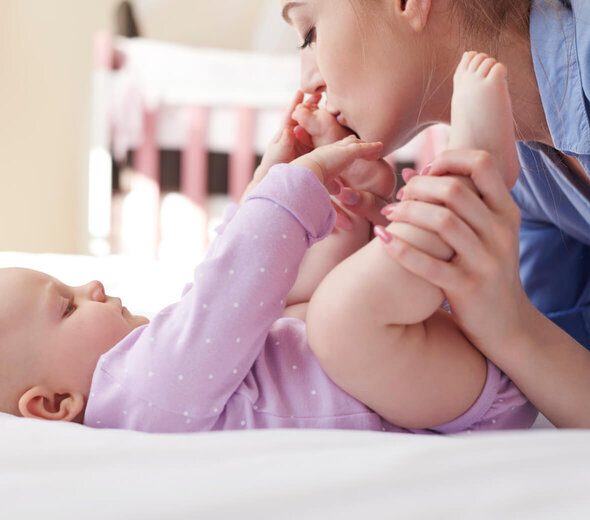

During pregnancy, the baby's legs are constantly bent and slightly parted outwards. Surely you have noticed that they did not straighten right after birth and it takes some time before your baby stands up and starts walking. Some toddlers start walking when they are s young as 9 months, but it happens that a child needs more time and begins to walk only when he is a year and a half. I know that we all want our baby to sit up, stand and walk as soon as possible. However, we shall not try to speed this process up. It is very important, as it affects proper development of the hip joints.
Baby's joints need time to be fully formed and prepared to carry the weight of a man for the rest of his life, thus proper care is particularly important, because it significantly affects their normal development and the future life of our child. Defects formed in childchood can result in back pains or abnormal gait. If you remember a few rules of playing with and caring of the baby, his hips will certainly be properly developed:
1. Try to put your baby on his tummy as often as possible. In this position the baby can watch the world from much better and more interesting perspective, and it is very good for the development of his hips and spine. If your baby does not enjoy lying on his tummy, try to do it for shorter period of time but more often. Try to encourage him to stay in this position by showing a musical or glowing toy, maybe this way he would get used to it and it will become his favourite position.
2. Remember not to pull the baby's feet while playing or changing. When changing a diaper it is enough to put your hand under his bottom.
3. Do not pull the baby's feet while playing, do not bend his legs to the chest and never play the 'bike' with him, because such maneuvers may have a negative effect on the normal development of the hip joint.
4. Try not to wrap your baby tightly in a diaper or a baby wrap. Maybe your baby will feel like back in your womb, but you must remember not to immobilize his legs.
5. Do not straighten baby's legs violently during dressing. Try to choose clothes that do not require a lot of stretching and effort to put on. Trousers and sleepsuits with buttoned legs are very useful. Remember that the clothes should be loose and should not hamper baby's movements. Too tight or too short clothes may lead to pathological formation of hip joints. When you notice that your baby can not stretch his legs it means you should change the rompers to a bigger size. Keep in mind that the clothes should not obstruct leg movements, e.g. a bodysuit or a nappy should not oppress the hip.
6. When the baby is lying on his tummy, never catch him by his calves or thighs to pull or fold them up and never pull him to the sides or backwards by his hands. Even if you did it gently, you can inadvertently harm your child.
7. Whenever possible, let your child kick a bit without diapers. It may be before and after bathing, dressing or changing. On a very warm day you can put the baby on a mat or a blanket (of course I recommend putting a protective mat under it).
8. If you measure your baby on your own at home, try not to stretch his legs. You surely have noticed that during the medical examination a nurse checking the baby's growth does not straighten his legs.
9. When you carry your child, try to place him astride on your hip so that his legs are parted. This position facilitates correct formation of the baby's hip joints.
10. One of the old, good and proven methods that affect the normal development of hip joints is called broad diapering, i.e. putting on broadly folded diaper cloths. Once the doctors recommended it to every child, but nowadays diapering is only justified in the case of children with hip dysplasia.
11. Do not put your baby into a baby walker, as it can cause serious faulty posture in adult life.
12. Do not speed up learning the standing and walking skills. Each child has his own rhythm and the fact that your child can stand up 2 months later than your neighbour's little one does not mean he is worse In fact, such help will only delay his development.
13. And most importantly, if your child can not sit up yet, do not help him at all costs. Do not support his back and put pillows around him. This is very dangerous for his spine and joints.
Hip joints examination is easy and completely painless. First, the doctor inspects the newborn's legs. He compares their length, the number of gluteal folds and their symmetricalness. He checks the length of the thighs and how the legs behave after abducting.
First examination of the baby's joints is carried out in a hospital, after delivery. A doctor should write its result in the baby's medical record book. Before leaving the hospital, make sure that your baby had all required tests. Regardless of whether the baby is healthy, or dysplasia was diagnosed, you need to report him to the follow up visit in the 6th week of his life. An orthopedist examines your baby thoroughly for defects in hip joints development and performs the ultrasound. This examination is compulsory.
If the results are correct the next visit is due only when the baby starts walking.